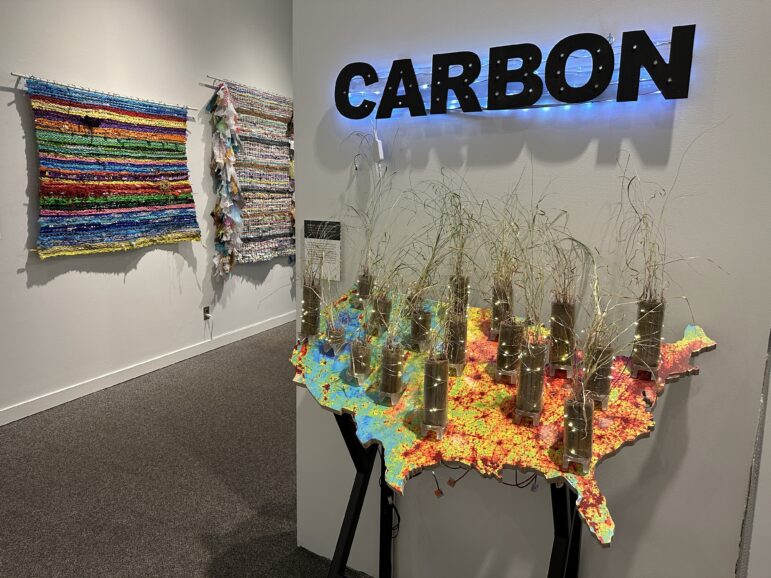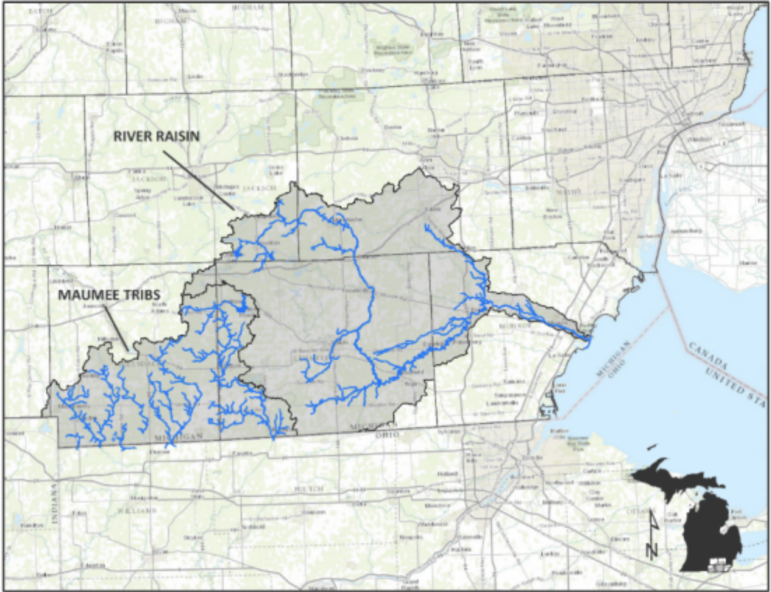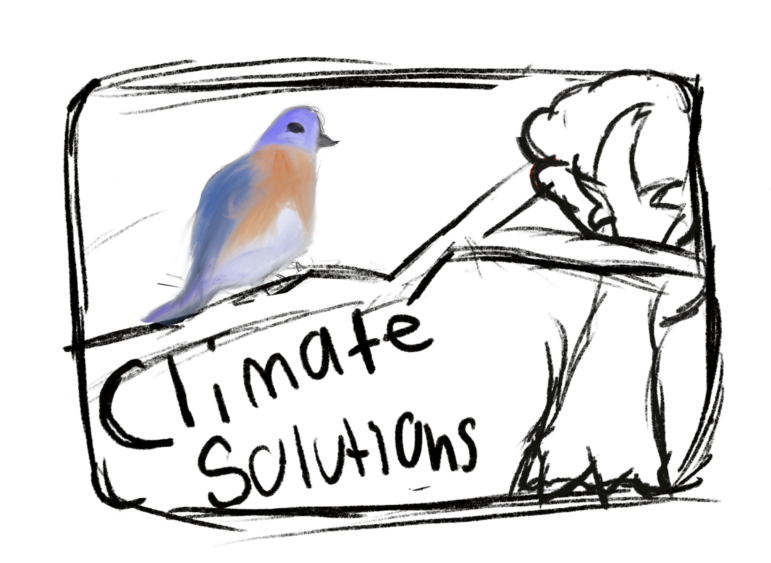By ABIGAIL COMAR
Capital News Service
LANSING – The Michigan State University Museum’s newest exhibition uses an interdisciplinary approach to engage visitors with the topic of climate change.
The exhibition, called “1.5° Celsius,” includes installations from 15 artists, researchers and scientists around the world.
The exhibition reflects the growing attention natural history and science museums are giving to climate change and its impacts.

Abigail Comar
One exhibit at 1.5° Celsius emphasizes how plants can help to store carbon dioxide in soil. Lowering carbon emissions is often a focus of climate change solutions.“1.5° Celsius” refers to the global temperature limit above pre-industrial levels, as defined by the 2015 Paris Agreement, to prevent irreparable damage to the Earth. The global temperature is currently at 1.1 degrees Celsius above those levels.
Devon Akmon, the MSU Museum director, said the exhibition’s curators aimed to inspire actions from visitors.
“We are living in a time of great urgency,” Akmon said. “It’s like the sand in the hourglass is ticking and there’s not much left.
“We’re almost in a sense of paralysis.”
Akmon said the main goal of the exhibition is to generate discussion about climate change.
One way the exhibition facilitates that process is with collaborators who work in the gallery.
Harmant Grewal, an MSU student collaborator – like a docent – said the exhibition is a perfect combination of science and art.
“Seeing it all come together to express a common theme of ‘we need to change’ so that we can improve our climate is really important to me,” Grewal said. “My favorite part is we’re able to teach people and help them understand the exhibits better.”
One driving force Akmon highlighted behind the development of the exhibition is that all museums have a responsibility to think about what it means to be relevant.
Another museum in the Great Lakes region educating about climate change is Science North in Sudbury, Ontario. Our Climate Quest is its traveling exhibition that aims to engage youth across Canada in climate action.
The museum also has the “Climate Action Show,” geared towards teaching children about climate change.

Department of Environment, Great Lakes and Energy
Map of the Upper Maumee River and River Raisin Watershed, where a wetland may be created to reduce phosphorus runoff into Lake Erie.Deb Kerr is the president and CEO of Intuit, the Center for Intuitive & Outsider Art, in Chicago and a museum studies instructor at Northwestern University.
She has an extensive background in science museums, including 17 years at the Shedd Aquarium in Chicago, and is a former member of the National Wildlife Federation’s Great Lakes Leaders Council.
Museums, Kerr said, are being held to a higher standard for relevance and meaning in society today.
“Young people really are thinking about everything,” Kerr said. “These are issues that are important to the emerging constituents.”
Kerr said Intuit’s youth programming focuses on social justice, which often includes projects focused around environmental problems and sustainability.
Kerr identified one struggle to stay relevant as the need for museums to balance funding and programming content.
“Museums live and die by donations,” she said. “Some of the largest donations come from corporations, and not all of those corporations are names we necessarily want to be associated with into the future.”
Therese Quinn, the director of museum and exhibition studies at the University of Illinois at Chicago, explained that the privatization of museums makes them more vulnerable to suspect funders.
Quinn gave the example of when she curated an exhibit about garbage and recycling for a children’s museum. Before the opening night for funders, the museum director censored some of the labels Quinn created for the exhibit.
Quinn said the museum was afraid that one of its larger funders, a waste management company, would be upset and withdraw support because of the content.
“1.5° Celsius” was funded primarily by the MSU Federal Credit Union.
Akmon said that the MSU Museum’s mission is geared towards the university community, which includes students, faculty, alumni and their families.
According to Akmon, an academic museum like his should be experimental and at the forefront of change.
Akmon said. “It should push boundaries. It should in some cases be a little provocative.”
Quinn said, “Many museums are still largely conservative spaces and not always willing to take the kind of risks with the content that could be disturbing for their visitors. Or, maybe more to the point, for their funders.”
“1.5° Celsius” isn’t the only climate-focused exhibition the MSU Museum is curating.
Akmon said it’s working on a new exhibition for spring 2023 in collaboration with the Smithsonian. The MSU Museum will be the first site for a national touring exhibition looking at climate change through the boreal forest.
Boreal forests grow in cold regions, where temperatures are freezing most of the year. Conifers, like pine and spruce trees, make up boreal forests.
Akmon said the exhibition will include more natural science collections and exhibits, using a historical context to look toward the future to explore climate change in boreal forests.

Asher Freedman
Climate solutions logo.Akmon, Kerr and Quinn emphasized the importance of young people in museum relevancy, particularly on the issue of climate change.
“I think these younger generations are pushing and applying pressure on museums to do something meaningful about what is arguably the most urgent issue of our time,” Quinn said.
Abigail Comar reports for Great Lakes Echo.